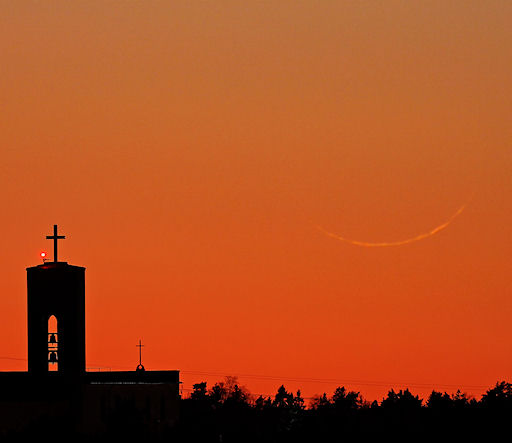Metallic photos of the sun by renowned photographer Greg Piepol bring together the best of art and science. Buy one or a whole set. They make a stellar gift. | | |
AURORA WATCH: A slow-moving coronal mass ejection (CME) launched from the sun on March 3rd should reach Earth later today, possibly sparking polar geomagnetic storms. High-latitude sky watchers should be alert for auroras.
SUNSET SKY SHOW: When the sun sets tonight, go outside and look west. Jupiter and the 5% crescent Moon will be side-by-side, shining together through the twilight. It's an exquisite conjunction. [sky map]
On March 5th, Peter Rosén caught the Moon, pre-conjunction, smiling over the tree tops of Stockholm, Sweden:

"The Moon was only 20h40m past 'new' when I took the picture," says Rosén. "It should look even better on Sunday night when it glides past Jupiter."
more images: from Marcin Grzybowski of Forslov, Sweden; from Bjørn H. Granslo of Røverkollen, Oslo, Norway; from Jan Andersson of Borås, Sweden; from Jin Lu of Tempe, AZ, USA
PLASMA RAIN: It's raining on the sun today. Micheal Buxton recorded the shower from his backyard observatory in Ocean Beach, California. Open your umbrella and click on the image, below:

"I captured the event at 1 minute intervals from 1901-1935 UT on 5 Mar 2011," says Buxton. "What a great day for observing the sun."
more images: from Alan Friedman at the Winter Star Party in West Summerland Key, Florida; from David Mason of Maidenhead, Berkshire, UK; from Dave Gradwell of Birr Ireland; from Szabolcs Szabó of Szolnok, Hungary; from Theo Ramakers of Social Circle,GA; from Teodorescu Maximilian of Dumitrana, Romania; from Enrico Colzani of Sormano Astronomical Observatory (Italy); from Stefano Sello of Pisa, Italy; from Roucheux Philippe of Joigny Bourgogne France; from David Cortner of Rutherford College, NC
March 2011 Aurora Photo Gallery
[previous Marches: 2010, 2009, 2008, 2007, 2006, 2005, 2004, 2003, 2002]
Potentially Hazardous Asteroids (
PHAs) are space rocks larger than approximately 100m that can come closer to Earth than 0.05 AU. None of the known PHAs is on a collision course with our planet, although astronomers are finding
new ones all the time.
On March 6, 2011 there were 1204 potentially hazardous asteroids.
Notes: LD means "Lunar Distance." 1 LD = 384,401 km, the distance between Earth and the Moon. 1 LD also equals 0.00256 AU. MAG is the visual magnitude of the asteroid on the date of closest approach. | | The official U.S. government space weather bureau |
| | The first place to look for information about sundogs, pillars, rainbows and related phenomena. |
| | Researchers call it a "Hubble for the sun." SDO is the most advanced solar observatory ever. |
| | 3D views of the sun from NASA's Solar and Terrestrial Relations Observatory |
| | Realtime and archival images of the Sun from SOHO. |
| | from the NOAA Space Environment Center |
| | the underlying science of space weather |
| | for out-of-this-world printing and graphics |

